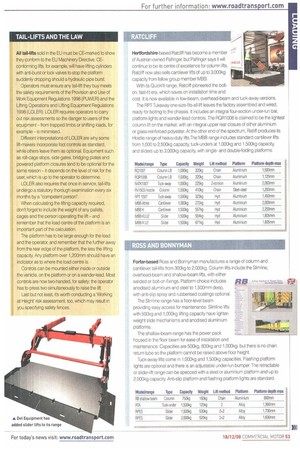TAIL-LIFTS AND THE LAW All tail-lifts sold in the EU
Page 53

If you've noticed an error in this article please click here to report it so we can fix it.
must be CE-marked to show they conform to the EU Machinery Directive. CEconforming lifts, for example, will have lifting cylinders with anti-burst or lock valves to stop the platform suddenly dropping should a hydraulic pipe burst.
Operators must ensure any tail-lift they buy meets the safety requirements of the Provision and Use of Work Equipment Regulations 1998 (PUWER) and the Lifting Operations and Lifting Equipment Regulations 1998 (LOLER). LOLER requires operators to carry out risk assessments so the danger to users of the equipment -from trapped limbs or shifting loads, for example is minimised.
Different interpretations of LOLER are why some lift-makers incorporate foot controls as standard, while others leave them as optional. Equipment such as roll-cage stops, side gates, bridging plates and powered platform closures tend to be optional for the same reason it depends on the level of risk for the user, which is up to the operator to determine.
LOLER also requires that once in service, tail-lifts undergo a statutory thorough examination every six months by a "competent person".
When calculating the lifting capacity required, don't forget to include the weight of any pallets, cages and the person operating the lift and remember that the load centre of the platform is an important part of the calculation.
The platform has to be large enough for the load and the operator, and remember that the further away from the rear edge of the platform, the less the lifting capacity. Any platform over 1,200mm should have an indicator as to where the load centre is.
Controls can be mounted either inside or outside the vehicle, on the platform or on a wander-lead. Most controls are now two-handed, for safety: the operator has to press two simultaneously to raise the lift Last but not least, it's worth conducting a Working at Height' risk assessment, too, which may result in you specifying safety fences.




































































































































































